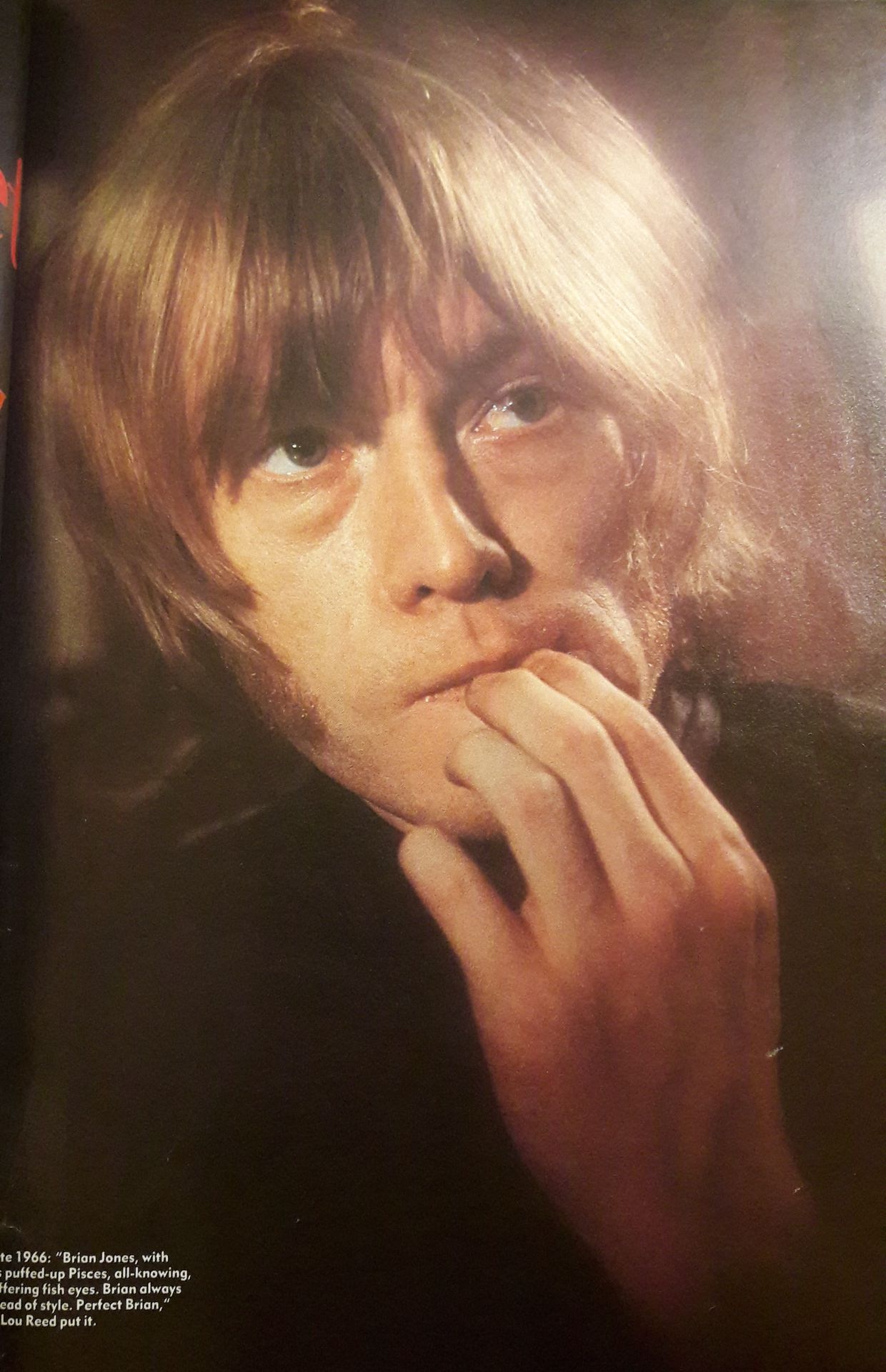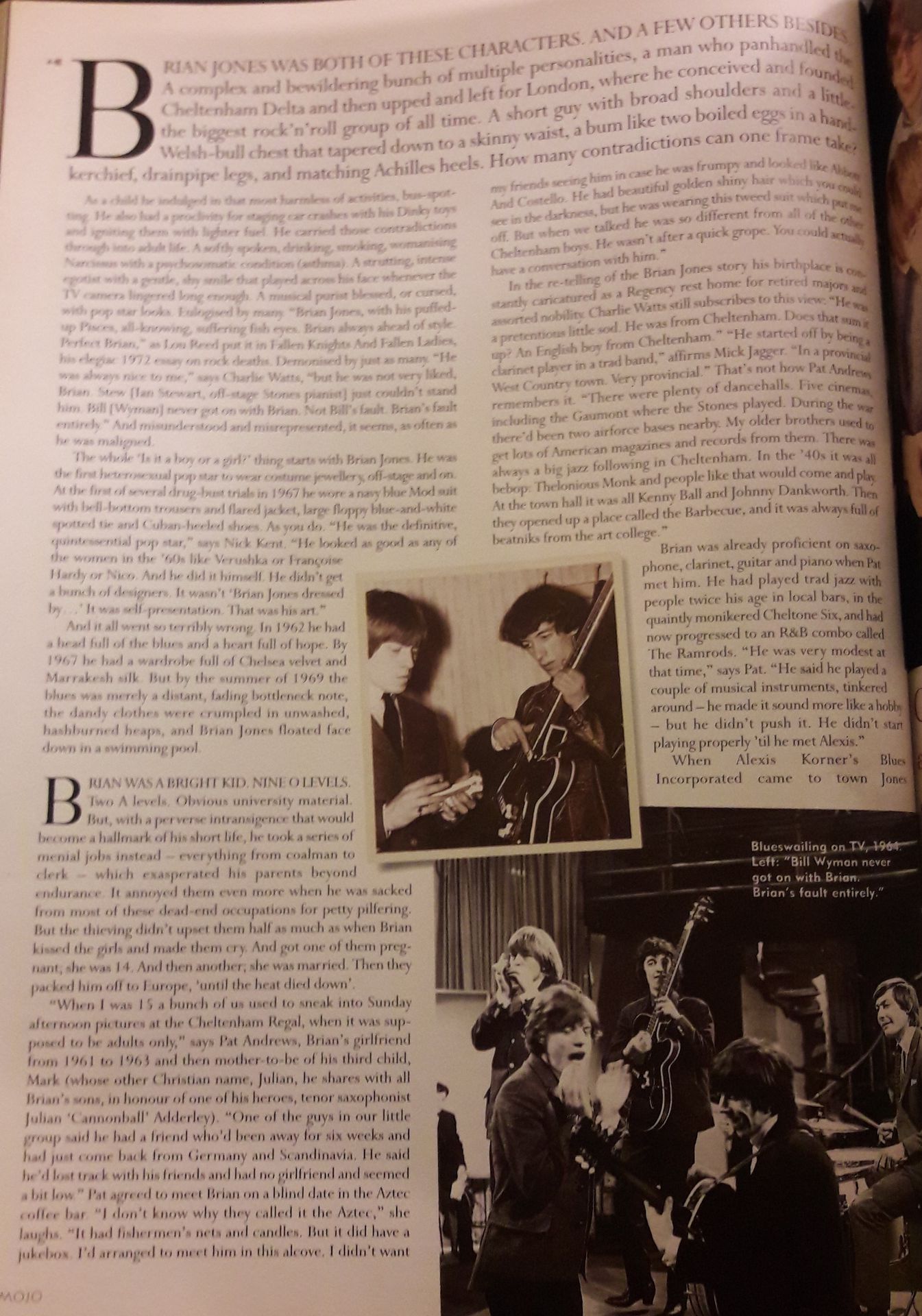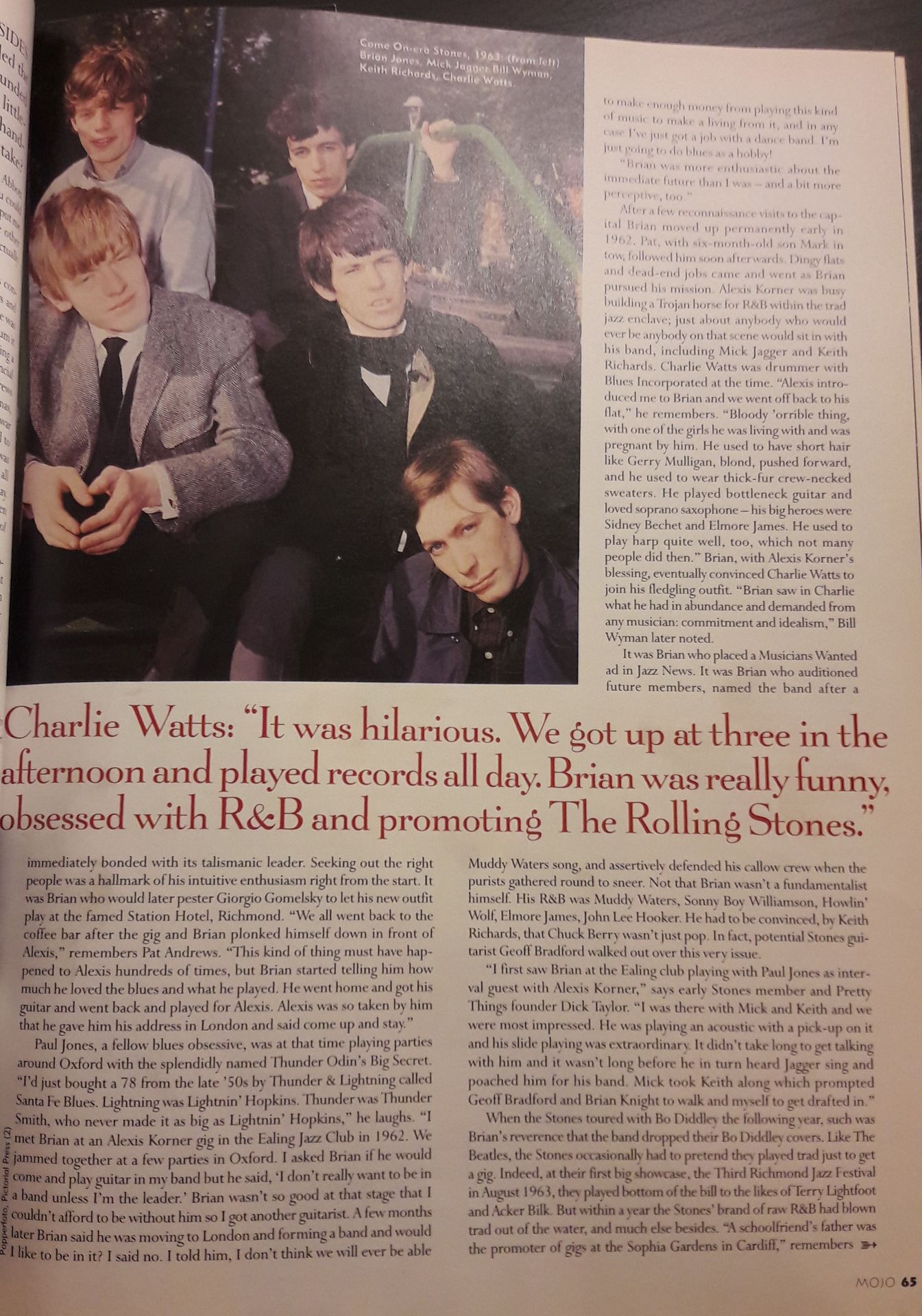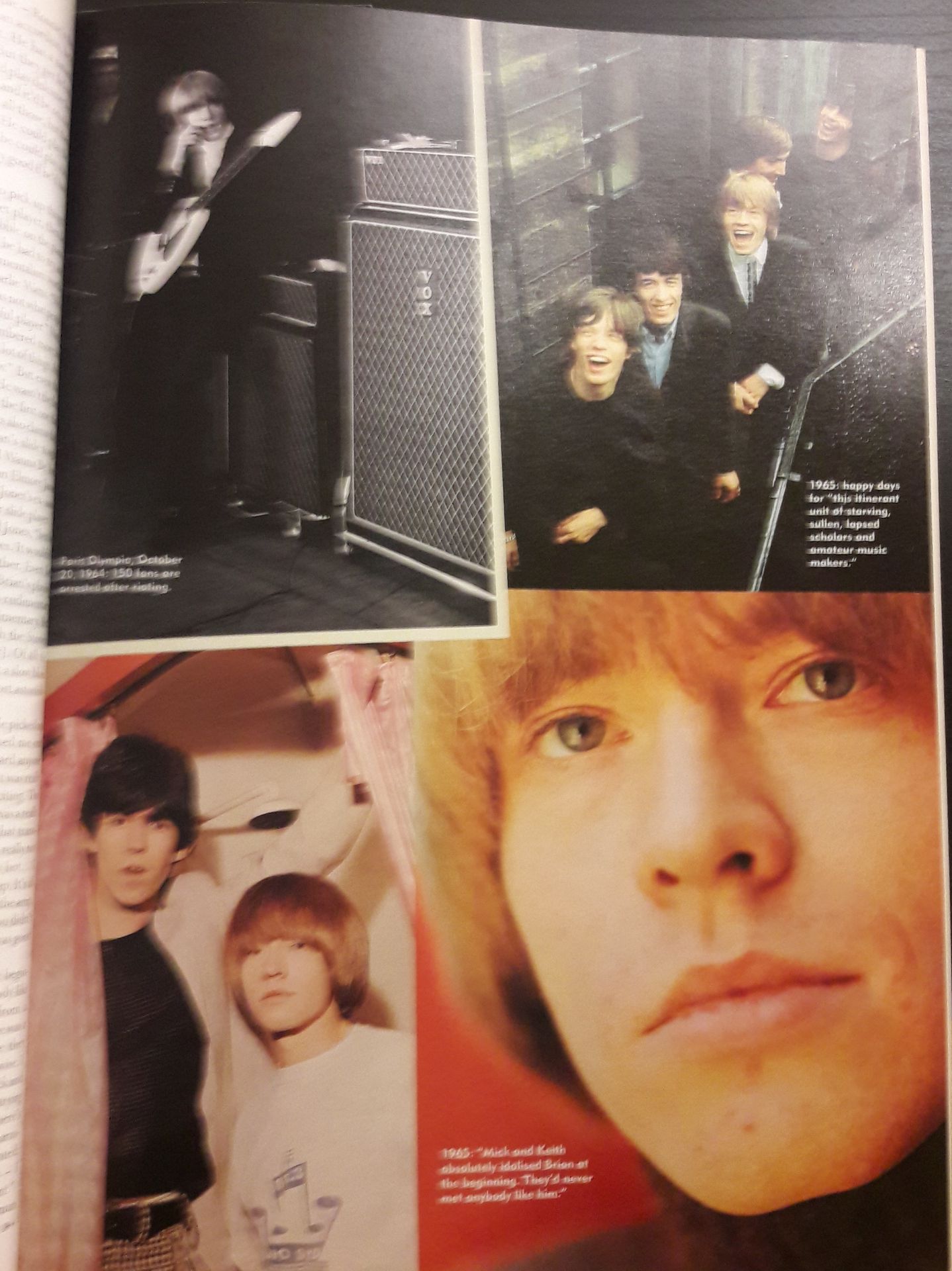The Bittersweet Symphony - MOJO July 1999 Part 1
Okay because I have like a million things on the Stones I decided to start going through everything again, so the following posts will be articles out of papers, books or whatever.
Anyway I'll start with the MOJO magazine article from 1999 where the Interview with Pete was in too. Partly because I can leave that part out and because it is one of the few things I actually have in English and don't need to translate first. It's very complete too, I mean you get a good insight into Brian and his life. (Though there are points I strongly disagree with, because well I probably need to write my own article to be fully happy with it.)
Warning: it's very long, so I split it up into several still kinda long parts.
The photographs are mine.

The Bittersweet Symphony
Rolling Stones founder, Rolling Stones Reject; ruthless controller, helpless passenger; blues obsessive, dabbler in the exotic, countercultural networker, paranoid recluse; adored Prince Charming, vicious heartbreaker; 60's legend, real life murder victim? Thirty years after his death, the twisted saga of Brian Jones.
By Rob Chapman. Portrait: Gered Mankowitz.

Chances are, regardless of the era or location you grew up in, there's a couple of types you've known at one time or another. Firstly, there's our resident Lothario-let's call him Vinnie- a little mad, bad and dangerous to know. The local tearaway. Vinnie's name often crops up in the same hushed breath as "back seat of a car", "knickers round her ankles", and "had to go for a while until the heat died down". Then there's this other guy. Let's call him Cedric. Bespectacled. Quiet. Nervy rather than nerdy. Disconcertingly distant, as if he's forever entertaining some private joke in your presence. Invited you round to his house one day and you wondered why he was so intent on playing his dad's record collection, until it dawned on you that these obscure discs in their thick cardboard sleeves by black artists you'd never heard of weren't his dad's at all. They were his and he seemed to know every note, every nuance.

Brian Jones was both of these characters. And a few others beside. A complex and bewildering bunch of multiple personalities, a man who panhandled the Cheltenham Delta and then upped and left for London, where he conceived and founded the biggest rock'n'roll group of all time. A short guy with broad shoulders and a little Welsh-bull chest that tapered down to a skinny waist, a bum like two boiled eggs in a handkerchief, drainpipe legs, and matching Achilles heels. How many contradictions can one frame take?
As a child he indulged in that most harmless of activities, bus-spotting. He also had a proclivity for staging car crashes with his Dinky toys and igniting them with lighter fuel. He carried those contradictions through into adult life. A softly spoken, drinking, smoking, womanizing Narcissus with a psychosomatic condition (asthma). A strutting, intense egotist with a gentle, shy smile that played across his face whenever the TV camera lingered long enough. A musical purist blessed, or cursed, with pop star looks. Eulogised by many. "Brian Jones, with his puffed up Pisces, all-knowing, suffering fish eyes. Brian always ahead of style. Perfect Brian," as Lou Reed put it in Fallen Knights And Fallen Ladies, his elegiac 1972 essay on rock deaths. Demonised by just as many. " He was always nice to me," says Charlie Watts, "but he was not very liked, Brian. Stew [Ian Stewart, off-stage Stones pianist] just couldn't stand him. Bill [Wyman] never got on with Brian. Not Bill's fault. Brian's fault entirely." And misunderstood and misrepresented, it seems, as often as he was maligned.
The whole 'Is it a boy or a girl?' thing starts with Brian Jones. He was the first heterosexual pop star to wear costume jewellery, off-stage and on. At the first of several drug-bust trials in 1967 he wore a navy blue Mod suit with bell-bottom trousers and flared jacket, large floppy blue-and-white spotted tie and Cuban-heeled shoes. As you do. "He was the definitive, quintessential pop star," says Nick Kent. "He looked as good as any of the women in the '60's like Verushka or Francoise Hardy or Nico. And he did it himself. He didn't get a bunch of designers. It wasn't 'Brian Jones dressed by. . .' It'was self-presentation. That was his art." And it all went so terribly wrong. In 1962 he had a head full of the blues and a heart full of hope. By 1967 he had a wardrobe full of Chelsea velvet and ' Marrakesh silk. But by the summer of 1969 the blues was merely a distant, fading bottleneck note, the dandy clothes were crumpled in unwashed, hashburned heaps, and Brian Jones floated face down in a swimming pool.
Brian was a bright Kid. Nine O Levels. Two A levels. Obvious university material. ; But, with a perverse intransigence that would become a hallmark of his short life, he took a series of menial jobs instead -everything from coalman to clerk which exasperated his parents beyond endurance. It annoyed them even more when he was sacked from most of these dead-end occupations for petty pilfering. But the thieving didn't upset them half as much as when Brian kissed the girls and made them cry. And got one of them pregnant; she was 14. And then another; she was married. Then they packed him off to Europe, 'until the heat died down'.
"When I was 15 a bunch of us used to sneak into Sunday afternoon pictures at the Cheltenham Regal, when it was supposed to be adults only," says Pat Andrews, Brian's girlfriend from 1961 to 1963 and then mother-to-be of his third child, Mark (whose other Christian name, Julian, he shares with all Brian's sons, in honour of one of his heroes, tenor saxophonist Julian 'Cannonball' Adderley). "One of the guys in our little group said he had a friend who'd been away for six weeks and had just come back from Germany and Scandinavia. He said he'd lost track with his friends and had no girlfriend and seemed a bit low." Pat agreed to meet Brian on a blind date in the Aztec coffee bar. "I don't know why they called it the Aztec," she laughs. "It had fishermen's nets and candles. But it did have a jukebox. I'd arranged to meet him in this alcove. I didn't want my friends seeing him in case he was frumpy and looked like Abbott And Costello. He had beautiful golden shiny hair which you could see in the darkness, but he was wearing this tweed suit which put my off. But when we talked he was so different from all of the other Cheltenham boys. He wasn't after a quick grope. You could actually have a conversation with him."
In the re-telling of the Brian Jones story his birthplace is constantly caricatured as a Regency rest home for retired majors and assorted nobility. Charlie Watts still subscribes to this view: "He was a pretentious little sod. He was from Cheltenham. Does that sum it Up? An English boy from Cheltenham." "He started off by being a clarinet player in a trad band," affirms Mick Jagger. "In a provincial West Country town. Very provincial." That's not how Pat Andrews remembers it. "There were plenty of dancehalls. Five cinemas, including the Gaumont where the Stones played. During the war there'd been two air force bases nearby. My older brothers used to get lots of American magazines and records from them. There was always a big jazz following in Cheltenham. In the '405 it was all bebop: Thelonious Monk and people like that would come and play. At the town hall it was all Kenny Ball and Johnny Dankworth. Then they opened up a place called the Barbecue, and it was always full of beatniks from the art college."
Brian was already proficient on saxophone, clarinet, guitar and piano when Pat met him. He had played trad jazz with people twice his age in local bars, in the quaintly monikered Cheltone Six, and had now progressed to an R&B combo called The Ramrods. "He was very modest at that time," says Pat. "He said he played a couple of musical instruments, tinkered around -he made it sound more like a hobby -but he didn't push it. He didn't start playing properly 'til he met he met Alexis." When Alexis Korner's Blues Incorporated came to town Jones immediately bonded with its talismanic leader. Seeking out the right People was a hallmark of his intuitive enthusiasm light from the start. It was Brian who would later pester Giorgio Gomelsky to let his new outfit play at the famed Station Hotel, Richmond. "We all went back to the coffee bar after the gig and Brian plonked himself down in front of Alexis," remembers Pat Andrews. "This kind of thing must have happened to Alexis hundreds of times, but Brian started telling him how much he loved the blues and what he played. He went home and got his guitar and went back and played for Alexis. Alexis was so taken by him that he gave him his address in London and said come up and stay."

Paul Jones, a fellow blues obsessive, was at that time playing parties around Oxford with the splendidly named Thunder Odin's Big Secret. "I'd just bought a 78 from the late '50s by Thunder & Lightning called Santa Fe Blues. Lightning was Lightnin' Hopkins. Thunder was Thunder Smith, who never made it as big as Lightnin' Hopkins," he laughs. "I met Brian at an Alexis Korner gig in the Ealing jam Club in 1962. We jammed together at a few parties in Oxford. I asked Brian if he would come and play guitar in my band but he said, 'I don't really want to be in a band unless I'm the leader.' Brian wasn't so good at that stage that I couldn't afford to be without him so I got another guitarist. A few months later Brian said he was moving to London and forming a band and would I like to be in it? I said no. I told him, I don't think we will ever be able to make enough money from playing this kind of music to make a living from it, and in any case I've just got a job with a dance hand. I'm just going to do blues as a hobby! "Brian was more enthusiastic about the immediate future than I was and a bit more perceptive, too."
After a few reconnaissance visits to the capital Brian moved up permanently early in 1962. Pat, with six-month-old son Mark in tow, followed him soon afterwards. Dingy flats and dead-end jobs came and went as Brian pursued his mission. Alexis Korner was busy building a Trojan horse for R&B within the trad jazz enclave; just about anybody who would ever be anybody on that scene would sit in with his band, including Mick Jagger and Keith Richards. Charlie Watts was drummer with Blues Incorporated at the time. "Alexis introduced me to Brian and we went off back to his flat," he remembers. "Bloody 'orrible thing, with one of the girls he was living with and was pregnant by him. He used to have short hair like Gerry Mulligan, blond, pushed forward, and he used to wear thick-fur crew-necked sweaters. He played bottleneck guitar and loved soprano saxophone his big heroes were Sidney Bechet and Elmore James. He used to play harp. quite well, too, which not many people did then." Brian, with Alexis Korner's blessing, eventually convinced Charlie Watts to join his fledgling outfit. "Brian saw in Charlie what he had in abundance and demanded from any musician: commitment and idealism," Bill Wyman later noted.
It was Brian who placed a Musicians Wanted ad in Jazz News. It was Brian who auditioned future members, named the band after a Muddy Waters song, and assertively defended his callow crew when the purists gathered round to sneer. Not that Brian wasn't a fundamentalist himself. His R&B was Muddy Waters, Sonny Boy Williamson, Howlin' Wolf, Elmore James, John Lee Hooker. He had to be convinced, by Keith Richards, that Chuck Berry wasn't just pop. In fact, potential Stones guitarist Geoff Bradford walked out over this very issue.
"I first saw Brian at the Ealing club playing with Paul Jones as interval guest with Alexis Korner," says early Stones member and Pretty Things founder Dick Taylor. "I was there with Mick and Keith and we were most impressed. He was playing an acoustic with a pick-up on it and his slide playing was extraordinary. It didn't take long to get talking with him and it wasn't long before he in turn heard Jagger sing and poached him for his band. Mick took Keith along which prompted Geoff Bradford and Brian Knight to walk and myself to get drafted in."
When the Stones toured with Bo Diddley the following year, such was Brian's reverence that the band dropped their Bo Diddley covers. Like The Beatles, the Stones occasionally had to pretend they played trad just to get a gig. Indeed, at their first big showcase, the Third Richmond Jazz Festival in August 1963, they played bottom of the bill to the likes of Terry Lightfoot and Acker Bilk. But within a year the Stones' brand of raw R&B had blown trad out of the water, and much else besides. "A schoolfriend's father was the promoter of gigs at the Sophia Gardens in Cardif ," remembers Nick Kent of his Damascene conversion as a 12' year-old in February 1964. "He got me backstage to meet them. Johnny Leyton was topping the bill. Jet Harris was on there. Their day was done. They weren't going to last another year. It was the changing of the guard culturally; the Stones just took that place. We had front-row seats and girls in the third row were threatening us with their stilettos. Backstage Brian was clearly the leader. The others were sulking around but Brian was smiling and talking to all the girls." The Rolling Stones' self-appointed leader had the musical acumen to back up his promotional skills. He 'worked out' blues harp, 'worked out' slide, ' 'worked out' the Bo Diddley beat, and later the dulcimer and sitar like they were mere maths equations.

Ginger Baker told Laura Jackson in her book Golden Stone how, during an early rehearsal with the fledgling Stones, he and Jack Bruce had played complicated patterns which completely succeeded in throwing Jagger. Jones had to go over to the singer and shout 1-2-3-4 to show him where the beat was. Pat Andrews also witnessed this early musical maturity first hand: "They were rehearsing in the Bricklayers Arms. Mick Avory or Carlo Little was on drums, I can't remember who. Dick Taylor was there and Brian Knight, too. They were doing this song and Mick was playing the harmonica. Brian was never the kind of person who would turn round and say, 'You're rubbish, He just pulled his harmonica out of his pocket and say, 'Mick, I think you should play it this way.' I'll never forget the look on Mick's face. It was like, 'Oh, shit. What else can this guy do?"
"Brian at that time had a certain amount of moodiness about him, but also a brilliant sense of humour and enthusiasm" says Dick Taylor. "He was very encouraging about my bass plying, which was nice as I only started to play the bass in order to work with the band and was quite unsure of my own ability on it. Both Keith and myself had a lot of respect for his musical abilities, which were quite a bit ahead of our own. We, and Mick, tried to steer things a bit more into the Chuck and Bo areas than maybe Brian wanted. "
"He was very diligent," remembers Paul Jones. "Once he got into something he wanted to do he went for it. I used to play harp in first position all the time. I wasn't good at bending notes. I could only really do the Jimmy Reed top end stuff. It was Brian who showed me quite early on how to cross harp and other positions. "
Working out instruments like they were logic puzzles was one thing. Charlie Watts, versed in the ways of the Jazz apprentice, doesn't necessarily think this made him a great musician. "Brian was one of these people- Ronnie's the same -if you left him in a room with an accordion, he'd play you a song in about two hours flat. He has a natural ability with an instrument. But they get fed up with it half-way through. He'd play dulcimer for a year and be very good on it, and it'd be on a lot of our records, Lady Jane and all those, but then he got fed up and that was it. He could play the Mellotron, he could play this, he could play a bit of that. He could have been very good if he'd have stuck at any of it. "
"Brian did have the ability to pick up things," agrees Jagger. "He was a clarinet player, then he played the guitar, and then he liked to dabble on the piano, then George Harrison played the sitar, so he had to try and learn, and so on." So was this multi-instrumentalism worthy of the plaudits? "No, not really," says Charlie Watts. "He's eulogised but he's not John Coltrane. He was not what people thought he was, and he was not a wonderful player." Watts view is that he is remembered more for being "the first one on a lot of things, that is special you know" But even this comes with qualifiers: "He wasn't the first one on slide. But he was the first one that people saw on telly " Watts also claims that, despite the way that Brian's slide toughened up their version of I Wanna Be Your Man ("We played it like an Elmore James song instead of like the bloody Beatles"), Jones's ex associate Geoff Bradford was actually a better slide player. "Geoff was marvelous," agrees Paul Jones, "but he would not have been right for the Stones. It wouldn't have been the Stones with me in it either. Even Ian Stewart would have spoiled that image. Brian's playing on I Wanna Be Your Man may have been rudimentary - everything about that record was rudimentary. But the thing for me, and always will be with the Stones, was Rooster Blues [Little Red Rooster]. Of all the wonderful things that they ever did, to get a slow blues to Number 1 on the UK chart was the most astonishing achievement of all."
Jagger is equally unequivocal in his assessment. "He picked up this Elmore James guitar thing which really knocked me out when I first heard him play it, because I'd never heard anyone play it live before-I'd only heard it on records. And it was really good. He really had that down and he was very exciting, The sound was right. The glissandos were all right. There was a really good gut feeling when he played it in the pub. And that translated all the way up to I Wanna Be Your Man- on this really not very good pop song, suddenly there was this really hot... I mean, you can play that stuff and it can sound like crap. It's all, to do with getting the right tone out of the guitar and the amp which in those days was relatively difficult to do- you didn't have all these boxes to make it up for you. No, he was good at that, he definitely was."
"Mick and Keith absolutely idolised Brian at the beginning, " says Pat Andrews. "They'd never met anybody Iike him, but I also think from a teenage point of view there was a animosity because they thought they were streetwise. think it was to do with Mick and Keith being from Dartford, trying to be London lads, and then this hick from Cheltenham, charming, really good-looking , talented well-educated, knowledgeable-l think it put their noses out of joint.
In December 1962 Bill Wyman enlisted in what he referred to in his autobiography Stone Alone as "this itinerant unit of starving, sullen, lapsed scholars and amateur music makers", and the classic Stones line-up was complete. By this time Brian, Mick, and Keith were sharing a flat together in Edith Grove, Chelsea, and concentrating full time on their music. Charlie Watts was a regular visitor: "It used to be hilarious all day. We used to get up at about three in the afternoon, just play records all day. And Brian used to be really funny in those days. Obsessed with R&B and promoting The Rolling Stones." Brian dipped his hand into cash registers and stole food to pay for band rehearsals and equipment during this crucial period. He would later elicit resentment when the other Stones discovered that he was paying himself an extra £5 as 'leader of the band'.

Bạn đang đọc truyện trên: Truyen247.Pro